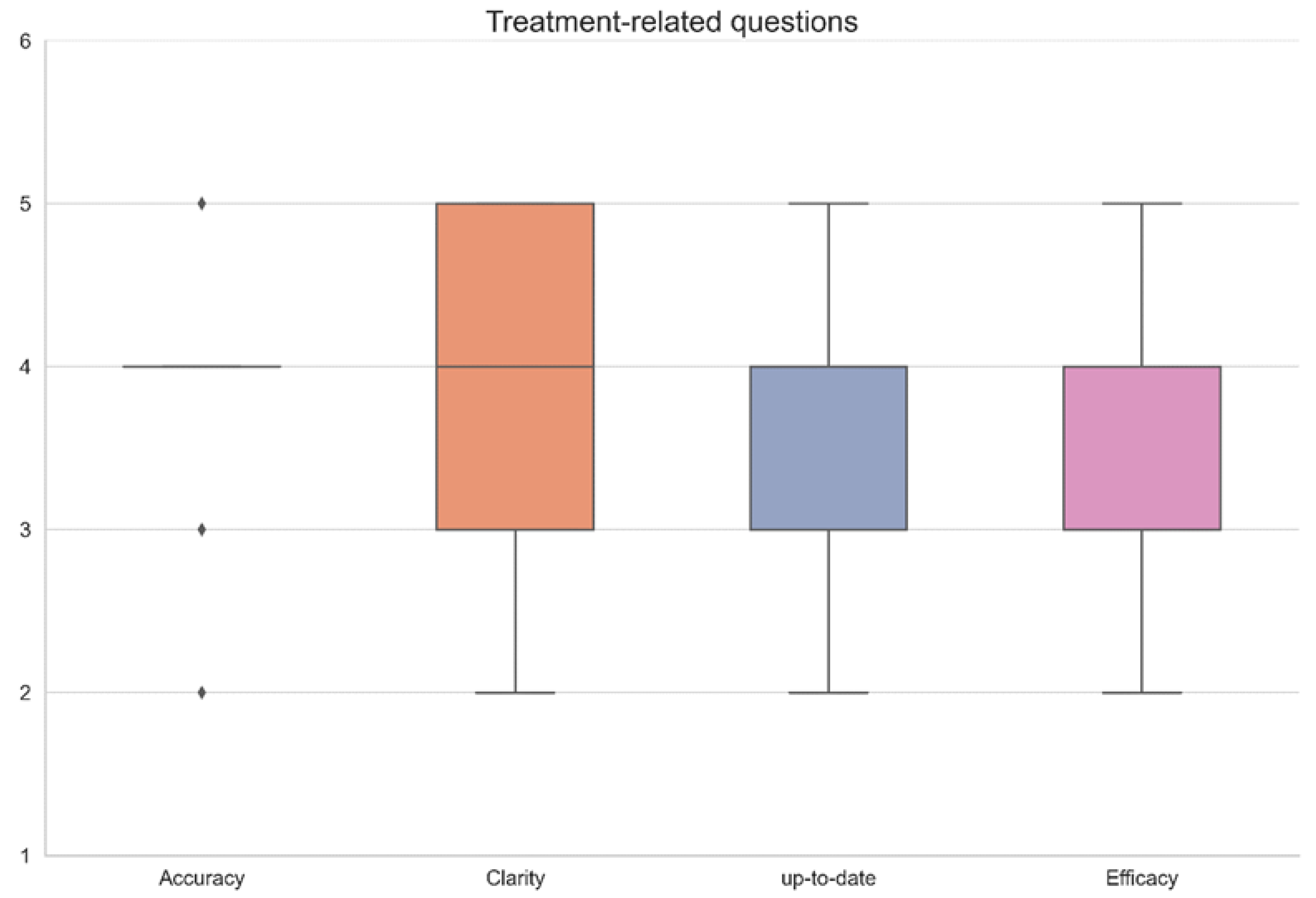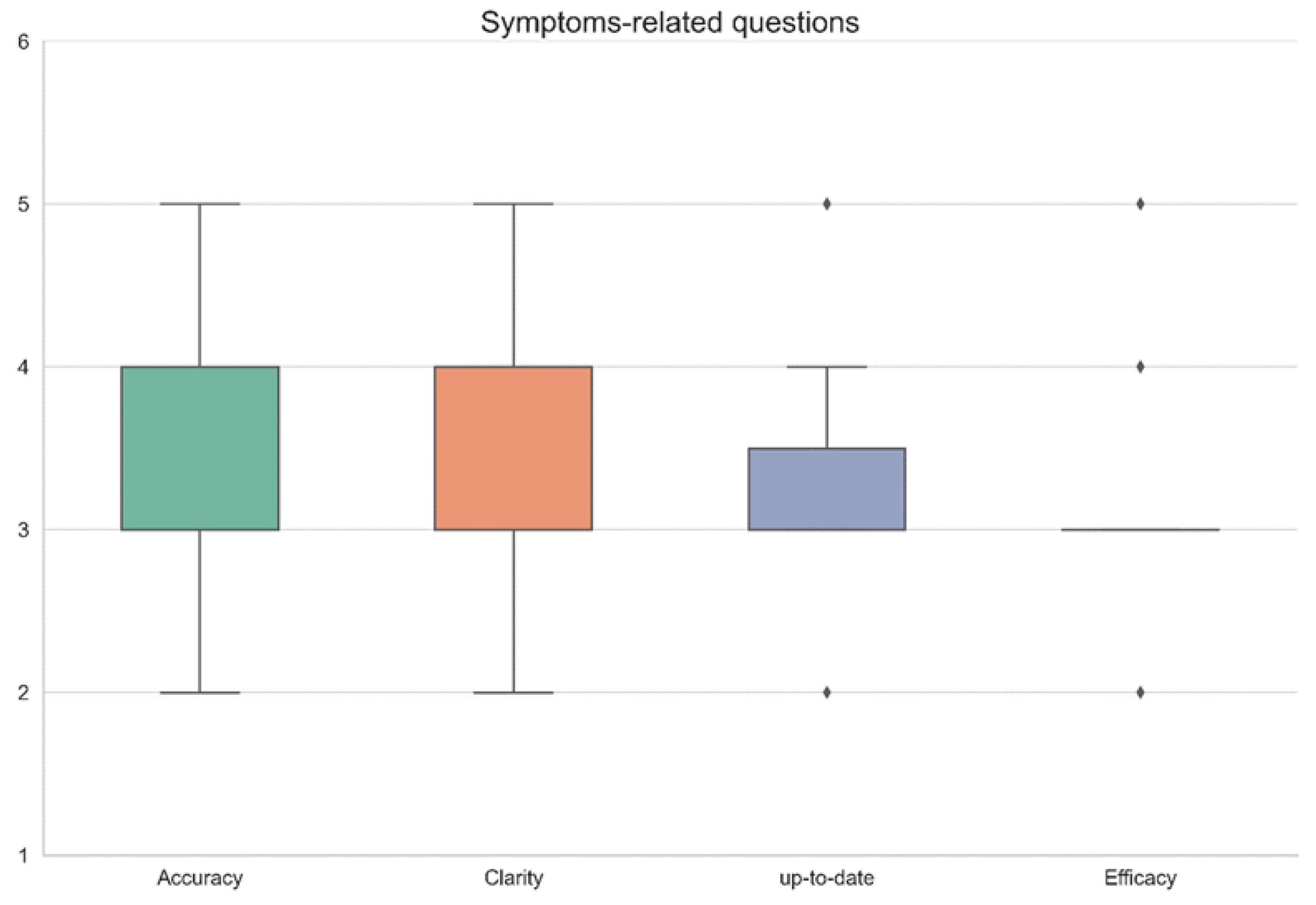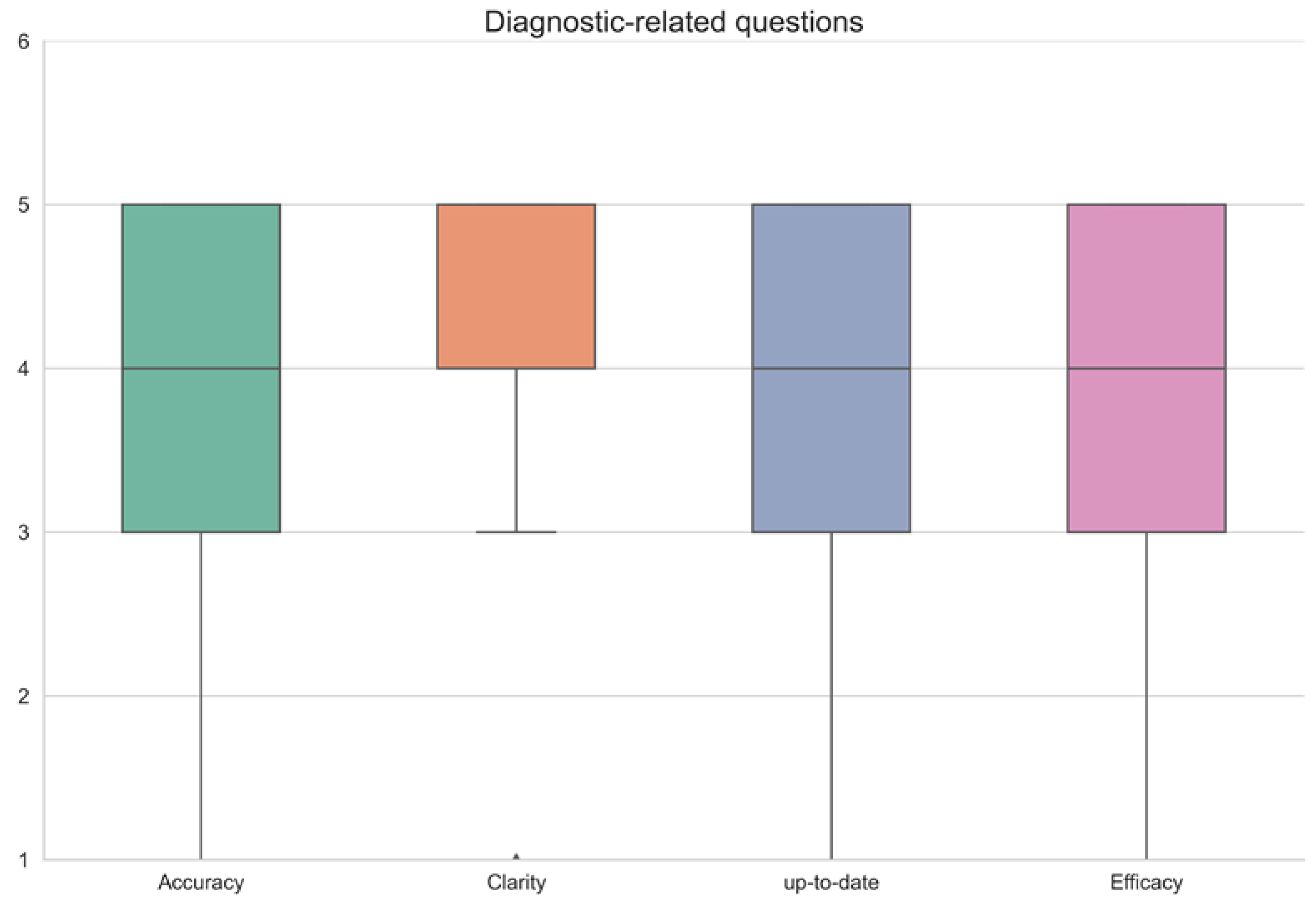Evaluating the Utility of a Large Language Model in Answering Common Patients’ Gastrointestinal Health-Related Questions: Are We There Yet?
Abstract
:1. Introduction
2. Methods
Statistical Analysis
3. Results
4. Discussion
Supplementary Materials
Author Contributions
Funding
Institutional Review Board Statement
Informed Consent Statement
Data Availability Statement
Conflicts of Interest
References
- Seifert, B.; Rubin, G.; de Wit, N.; Lionis, C.; Hall, N.; Hungin, P.; Jones, R.; Palka, M.; Mendive, J. The management of common gastrointestinal disorders in general practice: A survey by the European Society for Primary Care Gastroenterology (ESPCG) in six European countries. Dig. Liver Dis. 2008, 40, 659–666. [Google Scholar] [CrossRef] [PubMed]
- Holtedahl, K.; Vedsted, P.; Borgquist, L.; Donker, G.A.; Buntinx, F.; Weller, D.; Braaten, T.; Hjertholm, P.; Månsson, J.; Strandberg, E.L.; et al. Abdominal symptoms in general practice: Frequency, cancer suspicions raised, and actions taken by GPs in six European countries. Cohort study with prospective registration of cancer. Heliyon 2017, 3, e00328. [Google Scholar] [CrossRef] [PubMed] [Green Version]
- Available online: https://openai.com/blog/chatgpt/ (accessed on 1 March 2023).
- Lee, H.; Kang, J.; Yeo, J. Medical Specialty Recommendations by an Artificial Intelligence Chatbot on a Smartphone: Development and Deployment. J. Med. Internet Res. 2021, 23, e27460. [Google Scholar] [CrossRef] [PubMed]
- Montenegro, J.L.Z.; da Costa, C.A.; Righi, R.D.R. Survey of conversational agents in health. Expert Syst. Appl. 2019, 129, 56–67. [Google Scholar] [CrossRef]
- Palanica, A.; Flaschner, P.; Thommandram, A.; Li, M.; Fossat, Y. Physicians’ Perceptions of Chatbots in Health Care: Cross-Sectional Web-Based Survey. J. Med. Internet Res. 2019, 21, e12887. [Google Scholar] [CrossRef] [PubMed]
- Milne-Ives, M.; de Cock, C.; Lim, E.; Shehadeh, M.H.; de Pennington, N.; Mole, G.; Normando, E.; Meinert, E. The Effectiveness of Artificial Intelligence Conversational Agents in Health Care: Systematic Review. J. Med. Internet Res. 2020, 22, e20346. [Google Scholar] [CrossRef] [PubMed]
- Available online: https://www.bloomberg.com/news/articles/2022-12-07/openai-chatbot-so-good-it-can-fool-humans-even-when-it-s-wrong (accessed on 1 March 2023).
- Turing, A.M. Computing Machinery and Intelligence. In Mind; New Series; Oxford University Press on Behalf of the Mind Association: Oxford, UK, 1950; Volume 59, pp. 433–460. [Google Scholar]
- Vayena, E.; Blasimme, A.; Cohen, I.G. Machine learning in medicine: Addressing ethical challenges. PLoS Med. 2018, 15, e1002689. [Google Scholar] [CrossRef] [PubMed] [Green Version]
- Powell, J. Trust Me, I’m a Chatbot: How Artificial Intelligence in Health Care Fails the Turing Test. J. Med. Internet Res. 2019, 21, e16222. [Google Scholar] [CrossRef] [PubMed]
- Lahat, A.; Shachar, E.; Avidan, B.; Shatz, Z.; Glicksberg, B.S.; Klang, E. Evaluating the use of large language model in identifying top research questions ingastroenterology. Sci. Rep. 2023, 13, 4164. [Google Scholar] [CrossRef] [PubMed]
- Ge, J.; Lai, J.C. Artificial intelligence-based text generators in hepatology: ChatGPT isjust the beginning. Hepatol. Commun. 2023, 7, e0097. [Google Scholar] [CrossRef] [PubMed]
- Lahat, A.; Klang, E. Can advanced technologies help address the global increase in demand for specialized medical care and improve telehealth services? J. Telemed. Telecare 2023, 1357633X231155520. [Google Scholar] [CrossRef] [PubMed]
- Hirosawa, T.; Harada, Y.; Yokose, M.; Sakamoto, T.; Kawamura, R.; Shimizu, T. Diagnostic Accuracy of Differential-Diagnosis Lists Generated by Generative Pretrained Transformer 3 Chatbot for Clinical Vignettes with Common Chief Complaints: A Pilot Study. Int. J. Environ. Res. Public Health 2023, 20, 3378. [Google Scholar] [CrossRef] [PubMed]
- Eysenbach, G. The Role of ChatGPT, Generative Language Models, and Artificial Intelligence in Medical Education: A Conversation with ChatGPT and a Call for Papers. JMIR Med. Educ. 2023, 9, e46885. [Google Scholar] [CrossRef] [PubMed]
- Rasmussen, M.L.R.; Larsen, A.C.; Subhi, Y.; Potapenko, I. Artificial intelligence-based ChatGPT chatbot responses for patient and parent questions on vernal keratoconjunctivitis. Graefe’s Arch. Clin. Exp. Ophthalmol. 2023. [Google Scholar] [CrossRef] [PubMed]
- Samaan, J.S.; Yeo, Y.H.; Rajeev, N.; Hawley, L.; Abel, S.; Ng, W.H.; Srinivasan, N.; Park, J.; Burch, M.; Watson, R.; et al. Assessing the Accuracy of Responses by the Language Model ChatGPT to Questions Regarding Bariatric Surgery. Obes. Surg. 2023, 33, 1790–1796. [Google Scholar] [CrossRef] [PubMed]
- Xie, Y.; Seth, I.; Hunter-Smith, D.J.; Rozen, W.M.; Ross, R.; Lee, M. Aesthetic Surgery Advice and Counseling from Artificial Intelligence: A Rhinoplasty Consultation with ChatGPT. Aesthetic Plast Surg. 2023. [Google Scholar] [CrossRef] [PubMed]
- Yeo, Y.H.; Samaan, J.S.; Ng, W.H.; Ting, P.S.; Trivedi, H.; Vipani, A.; Ayoub, W.; Yang, J.D.; Liran, O.; Spiegel, B.; et al. Assessing the performance of ChatGPT in answering questions regarding cirrhosis and hepatocellular carcinoma. Clin. Mol. Hepatol. 2023. [Google Scholar] [CrossRef] [PubMed]
- Johnson, S.B.; King, A.J.; Warner, E.L.; Aneja, S.; Kann, B.H.; Bylund, C.L. Using ChatGPT to evaluate cancer myths and misconceptions: Artificial intelligence and cancer information. JNCI Cancer Spectr. 2023, 7, pkad015. [Google Scholar] [CrossRef] [PubMed]
- Johnson, D.; Goodman, R.; Patrinely, J.; Stone, C.; Zimmerman, E.; Donald, R.; Chang, S.; Berkowitz, S.; Finn, A.; Jahangir, E.; et al. Assessing the Accuracy and Reliability of AI-Generated Medical Responses: An Evaluation of the Chat-GPT Model. Res. Sq. 2023; preprint. [Google Scholar] [CrossRef]



| Question No. | Accuracy | Clarity | Up-to-Date | Efficacy | Remarks |
|---|---|---|---|---|---|
| 1 | 3 | 2 | 3 | 3 | |
| 2 | 3 | 4 | 3 | 3 | |
| 3 | 4 | 3 | 4 | 3 | |
| 4 | 4 | 4 | 4 | 3 | |
| 5 | 4 | 4 | 3 | 2 | |
| 6 | 5 | 5 | 4 | 4 | |
| 7 | 4 | 4 | 3 | 2 | |
| 8 | 4 | 4 | 3 | 2 | |
| 9 | 4 | 3 | 4 | 3 | |
| 10 | 5 | 5 | 4 | 4 | |
| 11 | 4 | 4 | 4 | 3 | |
| 12 | 4 | 4 | 3 | 3 | |
| 13 | 3 | 3 | 3 | 2 | |
| 14 | 4 | 3 | 4 | 3 | |
| 15 | 2 | 4 | 2 | 2 | |
| 16 | 4 | 3 | 4 | 4 | |
| 17 | 4 | 3 | 4 | 3 | |
| 18 | 4 | 5 | 5 | 4 | |
| 19 | 3 | 3 | 2 | 2 | |
| 20 | 3 | 4 | 4 | 3 | |
| 21 | 2 | 3 | 2 | 2 | |
| 22 | 4 | 4 | 4 | 5 | |
| 23 | 4 | 2 | 3 | 2 | |
| 24 | 3 | 4 | 3 | 3 | |
| 25 | 4 | 4 | 5 | 4 | |
| 26 | 4 | 5 | 5 | 4 | |
| 27 | 5 | 5 | 4 | 4 | |
| 28 | 4 | 5 | 5 | 4 | |
| 29 | 4 | 5 | 4 | 4 | |
| 30 | 5 | 4 | 5 | 5 | |
| 31 | 4 | 5 | 4 | 4 | |
| 32 | 4 | 5 | 4 | 3 | |
| 33 | 5 | 5 | 5 | 5 | |
| 34 | 4 | 3 | 4 | 3 | |
| 35 | 5 | 4 | 4 | 4 | |
| 36 | 3 | 3 | 4 | 3 | |
| 37 | 2 | 3 | 2 | 2 | |
| 38 | 4 | 3 | 4 | 3 | |
| 39 | 5 | 4 | 5 | 5 | |
| 40 | 4 | 5 | 4 | 4 | |
| 41 | 5 | 5 | 5 | 5 | |
| 42 | 4 | 4 | 5 | 4 | |
| Average ± SD | 3.9 ± 0.8 | 3.9 ± 0.9 | 3.8 ± 0.9 | 3.3 ± 0.9 | |
| Median (IQR) | 4 (4–4) | 4 (3–5) | 4 (3–4) | 3 (3–4) |
| Question No. | Accuracy | Clarity | Up-to-Date | Efficacy | Remarks |
|---|---|---|---|---|---|
| 1 | 3 | 4 | 3 | 3 | |
| 2 | 5 | 5 | 5 | 5 | |
| 3 | 3 | 4 | 3 | 3 | |
| 4 | 3 | 4 | 3 | 3 | |
| 5 | 3 | 4 | 3 | 3 | |
| 6 | 3 | 3 | 3 | 3 | |
| 7 | 4 | 4 | 4 | 4 | |
| 8 | 3 | 4 | 3 | 3 | |
| 9 | 3 | 4 | 3 | 3 | |
| 10 | 4 | 4 | 4 | 4 | |
| 11 | 3 | 3 | 3 | 3 | |
| 12 | 3 | 3 | 3 | 3 | |
| 13 | 2 | 3 | 2 | 2 | |
| 14 | 3 | 2 | 3 | 2 | |
| 15 | 4 | 4 | 4 | 3 | |
| 16 | 3 | 4 | 3 | 3 | |
| 17 | 3 | 4 | 3 | 3 | |
| 18 | 4 | 4 | 3 | 3 | |
| 19 | 3 | 3 | 3 | 3 | |
| 20 | 3 | 4 | 3 | 3 | |
| 21 | 5 | 3 | 4 | 4 | |
| 22 | 3 | 4 | 3 | 3 | |
| 23 | 5 | 5 | 5 | 5 | |
| Average ± SD | 3.4 ± 0.8 | 3.7 ±0.7 | 3.3 ± 0.7 | 3.2 ± 0.7 | |
| Median (IQR) | 3 (3–4) | 4 (3–4) | 3 (3–3.5) | 3 (3–3) |
| Question No. | Accuracy | Clarity | Up-to-Date | Efficacy | Remarks |
|---|---|---|---|---|---|
| 1 | 5 | 5 | 5 | 5 | |
| 2 | 5 | 4 | 4 | 3 | |
| 3 | 4 | 5 | 5 | 5 | |
| 4 | 4 | 5 | 5 | 4 | |
| 5 | 5 | 4 | 5 | 4 | |
| 6 | 5 | 4 | 4 | 5 | |
| 7 | 0 | 0 | 0 | 0 | Not found |
| 8 | 5 | 4 | 5 | 4 | |
| 9 | 1 | 1 | 1 | 1 | Mistake |
| 10 | 5 | 5 | 5 | 5 | |
| 11 | 5 | 5 | 5 | 5 | |
| 12 | 4 | 5 | 4 | 4 | |
| 13 | 5 | 5 | 5 | 5 | |
| 14 | 5 | 5 | 5 | 4 | |
| 15 | 5 | 5 | 5 | 5 | |
| 16 | 5 | 4 | 5 | 4 | |
| 17 | 5 | 4 | 5 | 4 | |
| 18 | 4 | 4 | 5 | 4 | |
| 19 | 5 | 4 | 5 | 4 | |
| 20 | 4 | 5 | 4 | 4 | |
| 21 | 5 | 3 | 3 | 3 | Asks info |
| 22 | 5 | 5 | 5 | 5 | |
| 23 | 0 | 0 | 0 | 0 | Not found |
| 24 | 5 | 5 | 5 | 5 | |
| 25 | 3 | 4 | 4 | 3 | |
| 26 | 3 | 4 | 4 | 3 | |
| 27 | 4 | 4 | 4 | 4 | |
| 28 | 5 | 5 | 5 | 5 | |
| 29 | 5 | 5 | 5 | 5 | |
| 30 | 3 | 4 | 3 | 3 | |
| 31 | 5 | 5 | 5 | 5 | |
| 32 | 4 | 5 | 5 | 4 | |
| 33 | 3 | 4 | 4 | 3 | |
| 34 | 5 | 5 | 4 | 5 | |
| 35 | 5 | 5 | 5 | 5 | |
| 36 | 1 | 1 | 1 | 1 | Mistake |
| 37 | 0 | 0 | 0 | 0 | Not found |
| 38 | 0 | 0 | 0 | 0 | Not found |
| 39 | 3 | 4 | 3 | 3 | |
| 40 | 4 | 5 | 4 | 4 | |
| 41 | 0 | 0 | 0 | 0 | Not found |
| 42 | 0 | 0 | 0 | 0 | Not found |
| 43 | 3 | 5 | 0 | 2 | |
| 44 | 5 | 5 | 4 | 5 | |
| 45 | 4 | 5 | 4 | 4 | |
| Average ± SD | 3.7 ± 1.7 | 3.8 ± 1.7 | 3.6 ± 1.8 | 3.5 ± 1.7 | |
| Median (IQR) | 4 (3–5) | 4 (4–5) | 4 (3–5) | 4 (3–5) |
Disclaimer/Publisher’s Note: The statements, opinions and data contained in all publications are solely those of the individual author(s) and contributor(s) and not of MDPI and/or the editor(s). MDPI and/or the editor(s) disclaim responsibility for any injury to people or property resulting from any ideas, methods, instructions or products referred to in the content. |
© 2023 by the authors. Licensee MDPI, Basel, Switzerland. This article is an open access article distributed under the terms and conditions of the Creative Commons Attribution (CC BY) license (https://creativecommons.org/licenses/by/4.0/).
Share and Cite
Lahat, A.; Shachar, E.; Avidan, B.; Glicksberg, B.; Klang, E. Evaluating the Utility of a Large Language Model in Answering Common Patients’ Gastrointestinal Health-Related Questions: Are We There Yet? Diagnostics 2023, 13, 1950. https://doi.org/10.3390/diagnostics13111950
Lahat A, Shachar E, Avidan B, Glicksberg B, Klang E. Evaluating the Utility of a Large Language Model in Answering Common Patients’ Gastrointestinal Health-Related Questions: Are We There Yet? Diagnostics. 2023; 13(11):1950. https://doi.org/10.3390/diagnostics13111950
Chicago/Turabian StyleLahat, Adi, Eyal Shachar, Benjamin Avidan, Benjamin Glicksberg, and Eyal Klang. 2023. "Evaluating the Utility of a Large Language Model in Answering Common Patients’ Gastrointestinal Health-Related Questions: Are We There Yet?" Diagnostics 13, no. 11: 1950. https://doi.org/10.3390/diagnostics13111950
APA StyleLahat, A., Shachar, E., Avidan, B., Glicksberg, B., & Klang, E. (2023). Evaluating the Utility of a Large Language Model in Answering Common Patients’ Gastrointestinal Health-Related Questions: Are We There Yet? Diagnostics, 13(11), 1950. https://doi.org/10.3390/diagnostics13111950







